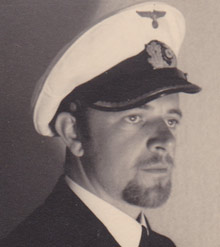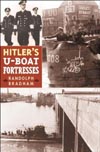The Sinking of SS Leopoldville
by Tonya Allen
On Christmas Eve, 1944, the S.S. Leopoldville made her final crossing of the English Channel. This Belgian passenger liner converted to troopship was carrying 2235 men of the 66th Infantry Division from Southampton to Cherbourg, reinforcements for the Battle of the Bulge. Five and a half miles from shore, the Leopoldville was struck by a torpedo fired by U-486, a Type VIIC U-boat commanded by Oblt. Gerhard Meyer. Several hundred of the troops were killed in the initial blast. Although the ship sank slowly, a combination of errors, delays, oversights and communication problems eventually resulted in the death of several hundred more infantrymen.
The Crossing
The disorganization and miscommunication which featured prominently in the last voyage of the Leopoldville actually began with the mobilization of the 262nd and 264th Regiments on 23 December. On that date, after weeks of waiting in camp in southern England, these regiments received the order to move out. Their half-prepared Christmas dinner was thrown away, duffel bags were packed, and the troops headed out to the harbor. Typically, the initial rush was followed by a six-hour wait on the docks. When boarding finally began at 0200hrs on 24 December, it seemed to follow no clear plan. The two regiments were mixed together and companies were separated, platoons randomly distributed throughout the 501-foot Leopoldville and on the other troop transport of the convoy, Cheshire, groups of men simply ordered to board as they appeared rather than by unit. This situation fragmented the command structure, contributing to an atmosphere of confusion and chaos. Later, it complicated the task of determining which soldiers were missing, and which had arrived safely on Cheshire.
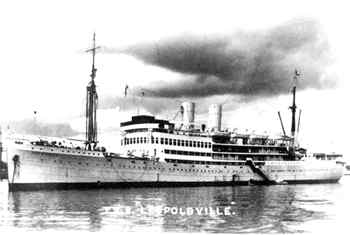
The S.S. Leopoldville
The 11,500-ton Leopoldville, launched in 1929, and since the war's beginning under charter to the British Admiralty, had a tired appearance which did not hearten the embarking troops. In fact, since 1940 the Leopoldville had transported over 120,000 men safely to their destinations (including the captured crew of U-570) and had crossed the English Channel 24 times, never being hit by enemy fire. Her crew had adjusted admirably to the change from more refined passenger service to bare-bones troop transport, and her current captain, Charles Limbor, had been in command since 1942.
In what seems to have been a typical troop transport experience, conditions on board were extremely crowded, uncomfortable, and in no way designed to boost morale or deliver a force in fighting trim. Enlisted men were expected to spend the 18 hours between boarding and disembarking sitting on benches in the converted cargo hold, although the more resourceful discovered hammocks and learned how to hang them, while others, exhausted by the march and wait in heavy field gear, quickly fell asleep on the floor. However, as the ship left the docks at Southampton, seasickness quickly set in among the soldiers, adding to the misery. Some were later to credit the nausea with saving their lives, as they were on deck or in the heads rather than in their assigned compartments when the torpedo hit.
At about 0900hrs the small convoy drew away from the docks. Although at the start of the crossing the infantrymen were called on deck for what was termed a boat drill, not all heard the order. This has been attributed to a combination of faulty loudspeakers in some of the holds, and the random dispersion of the infantrymen which sometimes separated them from their group leaders. Those who did arrive on deck simply stood at their assigned lifeboat stations as a few officers made spot checks of their gear and life jackets. No training in launching lifeboats or rafts was given, and few were instructed in the proper way to enter the water wearing the issued life jackets, omissions which would result in hundreds of deaths later that day.
The Leopoldville, followed by the Cheshire, was joined by HMS Brilliant, HMS Anthony, HMS Hotham, and the Free French frigate Croix de Lorraine after passing the harbor submarine nets. Brilliant then ordered Leopoldville and the other vessels to commence zigzagging, an command that had never before been given to Leopoldville during a Channel crossing, but which seemed advisable due to recent increased submarine activity. At 1430hrs, Brilliant reported an ASDIC contact. On the troopships, crews went to action stations, and the destroyers moved out to drop depth charges. At 1445hrs the alert was canceled, with no U-boat sighted, but another was called at 1500hrs, again being canceled at 1510hrs. The convoy resumed its diamond-shaped formation, with Brilliant, Leopoldville, Cheshire, and Croix de Lorraine in a line, and Anthony and Hotham taking wing positions, and recommenced zigzagging at 13 knots.
The Sinking
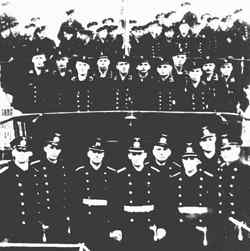 Crew of U-486
Crew of U-486
|
Five and one half miles off Cherbourg, U-486 lay submerged, awaiting a target. A recent lull in U-boat operations had given way to increased activity thanks to the implementation of the Schnorchel, which theoretically allowed the U-boat to remain submerged indefinitely. This particular U-boat had recently sunk her first ship, the British Silverlaurel. Launched on 12 February, 1944, she left Kiel for Norway on 6 November under Oblt. Gerhard Meyer (Crew 35). Arriving at Horten on 9 November, she underwent Schnorchel testing for 8 days before moving to Bergen and finally setting off for her patrol area in the English Channel, taking a route around the west coast of Ireland. When Leopoldville came into her range, she fired. At 1754hrs a torpedo wake was sighted from the troopship's deck. U-486 dove to the bottom and waited for depth charges; she later reported the hit, but was unable to confirm a sinking, as she had not observed it.
The torpedo struck the Leopoldville on the starboard side aft and exploded in Number Four Hold. Compartments E-4, F-4 and G-4 were flooded and stairways were blown away, but a few of the three hundred men in those compartments managed to escape to higher decks. Men in other parts of the ship who felt the blow and knew it for what it was began to make their way to the deck with laudable discipline and lack of panic. There they lined up in formation and waited for instructions.
Instructions were given, but not to the infantrymen. A series of contradictory messages over the loudspeaker announced variously that a tug was on the way; that men would be transferred to other ships at sea; and that the ship was not sinking. Then at 1816hrs Brilliant signaled Leopoldville to drop anchor; having done so, at 1825hrs Captain Limbor ordered all but essential crew to abandon ship. It was still not apparent by the list of the ship that it was indeed sinking, but to the massed men standing on deck, the sight of much of the ship's crew taking to the lifeboats and rowing away did not inspire confidence.
Delays in initiating rescue operations were many. First was the basic problem of an indirect communications route. The Brilliant had to signal Portsmouth rather than Cherbourg because the US forces in France were tuned to a different radio frequency than that used by the British, and additionally could not read the British code. Portsmouth's subsequent telephone call to Cherbourg was delayed for nearly an hour for reasons that have not been explained.
A second cause of delay was the failure of any ship of the small convoy to reply to blinker signals from shore. The Americans at Fort L'Ouest (Cherbourg), noticed immediately that the convoy had stopped, and soon observed that one of the vessels was drifting toward a minefield. However, repeated attempts on the part of Fort L'Ouest to signal Leopoldville and the convoy with blinkers brought no reply until 1825hrs, when Brilliant signaled: "Leopoldville hit, need assistance". Fort L'Ouest blinkered back inquiring as to the kind of assistance needed, but received no reply.
An important further cause of delay was the Christmas holiday itself. In the harbor at Cherbourg lay several hundred vessels which could have served as rescue craft, but all were lightly manned due to the holiday and all had cold engines. All posts on the base were minimally staffed due to attendance at holiday parties, a situation that significantly slowed communications, decisions and orders.
After the majority of the crew had abandoned ship on Limbor's order, at 1825hrs, having signaled Fort L'Ouest, the Brilliant approached and maneuvered alongside the Leopoldville. This was a difficult task, because the empty lifeboat davits were out on the port side, and two lifeboats were swung out on the starboard side. Brilliant was forced to crush these boats in order to close the sinking ship. A lively sea repeatedly bashed the two vessels together, then drew them apart. One by one, hundreds of men took their turn to attempt the leap from the Leopoldville to the destroyer; the majority succeeded, but others mistimed their jumps and were crushed to death as the two hulls came together.
At 1920hrs the battered and overloaded Brilliant was forced to pull away, having taken on about 500 men. As she headed for shore she passed the first rescue craft which were finally leaving harbor and heading to the scene of the sinking ship. The other escorts in the convoy were still hunting the U-boat, as commander of Brilliant and Convoy Commander John Pringle judged that the Cherbourg rescue craft could take all the remaining men off before the ship sank. He was later to be questioned on this error in judgment.
At this time, a few rescue craft began to approach and take men off, but it was a slow process. At 2000hrs there were still 1200 troops on board, as well as 25 Belgians and 10 British officers. At this point, Limbor ordered the remaining Belgians and British to abandon ship, although he himself remained on board with a few of his crew who stood by him, thus leaving virtually no one with any knowledge of seamanship to aid in the rescue process. (When ropes were thrown by Navy rescue tug ATR-3, there was no one who knew what to do with them. Finally a soldier grabbed one and managed to secure it.) After the crew had departed and with the loudspeaker no longer operational, Limbor walked around the ship giving the order to the troops to abandon ship. Since he gave it in French or Flemish amid scenes of much confusion and to men who had no idea how to launch the rafts, it had little effect.
At some point between 2020hrs and 2040hrs, two explosions were heard from the bowels of the ship, and hatch covers blew off, sending some men into the water. Then the foundering vessel began to heel sideways as well as sinking stern down. Rafts and other equipment broke loose from the deck and swept men into the sea. The rest of the men soon followed, either jumping, walking down the overturned side into the water, or simply stepping off as the deck fell away beneath them.
In the Water
The 48-degree water was suddenly crowded with hundreds of struggling men. In the more than two hours they had stood on deck, no one had instructed them to prepare to enter the water by removing their heavy clothing or gear. Now they were in a rough sea weighed down by their full field kit. Most quickly divested themselves of their boots, rifles, ammunition belts, axes and entrenching tools, but their heavy winter overcoats were under the life jackets, and thus could not be removed.
Others were already dead, killed instantaneously by their own gear. They had not been instructed how to safely enter the water wearing their lifejackets and helmets. On striking the water, if not tied together tightly, the two pillows which formed the front and back of the jacket snapped up with great force and broke the wearer's neck. The same occurred with helmet straps if not unfastened.
The initial panic and clamor soon died away as the sea dispersed the crowds into small clusters and isolated individuals. Many men quickly drowned or became numbed to unconsciousness. Those who were strongest, most determined, or lucky enough to find wreckage to cling to managed to survive until help arrived.
As rescue vessels moved among the men in the darkness of the winter evening, in addition to survivors many bodies were taken aboard as well. The freezing temperatures sometimes made it difficult to tell the difference. With a catastrophe of this proportion, speed was of the essence, but while haste saved many, it also sealed the fate of a few. Seemingly lifeless bodies were given a cursory check by medics ashore and then stacked up on the pier at Cherbourg, where the few who had been clinging to life died there of hypothermia.
Captain Limbor went down with his ship, the only officer not to survive the sinking. One Belgian crewman and 3 Congolese crewmen died. The Admiralty has not yet released figures on the number of British lost, although it is certain that it was less than 10. The official number of US infantry dead was calculated at 763.
The End of the War and the Sinking of U-486
1400 infantrymen had survived. They were taken to shore and hospitalized or sheltered in makeshift housing for the night. The day after Christmas, the bulk of the survivors pitched camp on a racetrack on the outskirts of town, where they spent a week. Then they moved on to Rennes, and finally to the Lorient/St-Nazaire perimeter, where 50,000 German troops were contained in two pockets.
There was little fighting in this area; in next 5 months only 43 casualties occurred among the 262nd and 264th Regiments. It has often been thought that because of their vastly diminished size, these two regiments were diverted from their original destination and were instead assigned to the less dangerous duty at Lorient/St.-Nazaire. If this had indeed been the case, then those who survived the sinking would actually have had it to thank for giving them a better chance of surviving the war. However, official records show that it had already been decided to send the experienced 94th Division to the heaviest fighting at the Bulge instead, so the 66th had after all originally been destined for the Lorient duty. Thus, the sinking had no impact on the regiments' assignment.
On 26 December, U-486 sank two more ships, HMS Affleck and HMS Capel, then was sent to patrol off Bergen in mid-January. She met her end on 12 April, 1945, being sunk with all hands by the submarine HMS Tapir due to a Schnorchel malfunction which forced her to surface.
Investigation, Embarrassment, and Misinformation
The sinking was a coup for the Germans, who broadcast the details, including the ship's name and the regiments aboard, within the next few weeks. A few short columns, stripped of dates and details, appeared in US newspapers.
London, 7 January, 1945 (U.P.) - A German communiqué asserted today that U-boats had sunk an 11,000-ton vessel used as a troop transport off Cherbourg, one of the main Allied supply ports in France, and that they had sent nine other vessels, including five warships, to the bottom in attacks on Allied shipping since January 1. There was no Allied confirmation of these claims.
London, 14 January, 1945 (A.P.) - The German radio speculated today that the Leopoldville, former Belgian passenger liner, had been sunk between England and France while in use as an Allied troop transport. Berlin said that two lifeboats bearing the liner's name had been washed ashore in the Channel Islands, and that one of the boats yielded military equipment "establishing that troops of the 262nd US Infantry Regiment had been shipwrecked." There was no Allied response to these claims.
A month after the sinking, an account was published in US newspapers, although due to wartime security concerns it was deliberately inaccurate.
Washington, 25, January, 1945. Philadelphia Inquirer Washington Bureau.
- A troopship carrying more than 2200 American soldiers was sunk recently in European waters with the probable loss of 765 men, Secretary of War Henry Stimson announced today.
"The ship sank swiftly," he said, "and 248 men were killed and 517 are missing. The rest, over 1400, were saved."
[The ship of course did not sink swiftly, and the "missing" men were in fact known dead.]
While Mr. Stimson did not comment, it was assumed not only that the troopship was sunk as a result of submarine action, but that the sinking was a reflection of the warning of a spurt in U-boat activity, sounded a few days ago in the monthly submarine statement issues jointly by Prime Minister Winston Churchill and President Roosevelt.
It also focused attention on the comment made yesterday by General A.G.L. McNaughton, Canadian Defense Minister, that "today the North Atlantic is, as it hasn't been for months past, alive with German submarines."
Mr. Stimson said that announcement of the loss of the ship, one of the most severe suffered by the United States in the present war, was made "in accordance with our established policy of stating all losses in regular course even though some of the details may not yet be available."
The Navy Department decline comment upon the sinking, pointing out that details would be made available, when security permitted, through US naval sources in London.
Investigations into the affair drew conclusions of multiple errors committed by several parties, overall lack of precautions, and complacency. The conduct of Pringle, commander of Brilliant, was criticized on the following grounds:
He did not specify to Fort L'Ouest that his situation was critical. No SOS or mention of emergency was made, and he did not indicate that the damaged vessel was carrying troops. This latter may be attributable to the fact that he himself was not aware the ship carried troops until after it was hit, in itself a questionable state of affairs.
Having learned that the Leopoldville carried troops, but under the impression there were 4000 men aboard, he judged that the escorting destroyers would not have capacity to take off all the men, and thought she should be towed instead.
He did not order the anchor dropped until 30 minutes had passed, allowing the ship to drift toward a minefield. However, his eventual order to drop anchor conflicted with his earlier judgment that she should be towed. Tugs, when they came, could not move the ship because she was anchored and the ship's crew had already abandoned the vessel.
He did not withdraw one or more of the three other destroyers from their hunt for U-486 to take troops off, at first, as mentioned above, because he intended the vessel to be towed, and later because, observing rescue craft approaching from Cherbourg, he felt "the situation was well in hand."
At the moment Brilliant cast off from Leopoldville after herself taking off 500 men, her log shows that a message was received from Leopoldville indicating that swift abandonment was imperative. However, Pringle did not receive that message until after the affair was over, and could not explain why this was so.
(Pringle received an official reprimand, but continued his naval career for a further decade.)
Limbor and the crew of the Leopoldville were also faulted on several counts:
Limbor, captain of the Leopoldville, failed to appraise the damage to his vessel, and consequently failed to realize the ship was sinking slowly and could easily have been towed and beached. From his words and actions it seems he was struck at the outset with a fatalistic conviction that the ship was lost.
At Limbor's order, the majority of the ship's crew departed before the passengers, thus leaving virtually no one capable of launching lifeboats or rafts, raising the anchor, or fastening a towline. Given that Limbor believed the ship was lost, it can be assumed he realized that by putting the safety of his crew first, he was decreasing the chances that the troops would be rescued.
No drill or training in use of life belts or launching of life boats and rafts was carried out before the torpedo struck, and afterwards there were no crew aboard to provide guidance. (As it became apparent in the last moments that the ship would sink, infantrymen made ineffective attempts to cut the heavy ropes securing boats and rafts with their penknives.) As noted, improperly worn life belts and strapped-on helmets resulted in many broken necks.
No official abandon ship order was given. This led to confusion among the troops, some of whose superior officers forbade them to jump to the Brilliant or other craft on the grounds that they had received no order to leave the vessel. It also created a false sense of security among the infantrymen, most of whom were unaware the ship was in a sinking condition until the very end, leading many to refuse the dangerous jump to Brilliant and other rescue craft.
The Port of Southhampton did not escape censure, as the incident revealed that slapdash loading and record-keeping were not rare:
The Cheshire arrived on 24 December without a passenger list. One forwarded later from Southampton to Cherbourg contained many errors.
The Leopoldville passenger list also contained many errors. Because, as noted earlier, the regiments had been split up and boarded randomly onto the two ships, it was difficult to determine exactly who and how many had been lost. This accounts for some of the difficulty in determining how many were killed in the initial blast, as opposed to after the ship sank.
The port had four times previously in recent months dispatched troopships without passenger lists.
No official criticism was levied against the Americans. All agreed the troops had displayed no panic and had committed many acts of personal heroism in rescuing those trapped below decks where the torpedo had struck. The fragmented command structure might be blamed for the lack of instruction as to how to abandon ship safely; but, as the vessel did not develop a notable list until shortly before she sank, most of the men did not realize they were in any danger. Doubtless personal initiative as well as group leadership would have emerged and resulted in better preparation to enter the water if it had been known that the ship would certainly sink.
Although it was not stated explicitly in official reports, it was clear that the Americans at Fort L'Ouest had allowed the Christmas holiday to degrade their level of vigilance. A reference to this is apparent in one report's recommendations for improving rescue-readiness of Cherbourg harbor craft.
In short, the investigation revealed the incident as a debacle from start to finish. A memo relating the details to General George C. Marshall on 6 January, 1945 included the observation "Had this disaster occurred in peacetime, it would have been regarded as a shocking scandal." The decision on all sides was to keep silence: to avoid boosting U-boat morale by acknowledgement of the great loss of life; to avoid straining Allied relations; and to prevent a lowering of morale on the home front. Only the second of these three reasons for keeping silence had any real basis. The Germans knew enough details to count the sinking as a major U-boat victory. The losses of the Battle of the Bulge were not withheld out of similar concern for the morale of Americans at home. Embarrassment was the main motivating factor for downplaying the disaster as far as possible.
Those bodies which had been recovered (493 were never found) were buried on 25 and 26 December in Blosville-Carentan and other nearby areas, and the incident was buried with them. Survivors were instructed not to write home about the sinking and wartime censorship was generally effective in enforcing the order. The investigation files were sealed. Relatives of the dead were given incomplete information. Death notifications, as customary after large losses, were spread out over months, with some receiving definite notice of death in January, while others who were known to the authorities to be dead were listed as missing for some months. Families who inquired for details as to their loved ones' deaths were sent form letters to the effect that no further information was available.
After the war, the incident remained undisclosed. An official British memo of 19 March, 1946 stated: "The story of the Leopoldville does not reflect any great credit upon us, and I should be averse to disclosing it unless the need is very strong. To issue anything publicly in America might only serve to revive a controversy that would be better allowed to die."
In 1958-1959, US military documents regarding the case were declassified. However, the government made no effort to inform families of the details. In the early 1960s Jacquin Sanders, who had watched the Leopoldville fall out of line from his place on the deck of the Cheshire, documented the sinking using available information in A Night before Christmas. A 66th Division history also recounted the outline of events. But the disaster still eluded public knowledge until the wreck was located and the story researched and publicized in two other books.
The Wreck
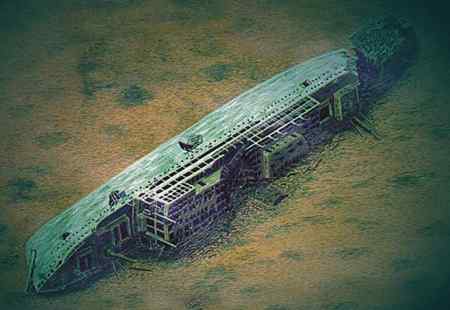 Wreck of Leopoldville today |
In 1984, Clive Cussler and his shipwreck-hunting organization NUMA entered the Cherbourg area with the intention of searching for both Leopoldville and the Confederate raider Alabama. After being denied permission by the French Navy to search for Alabama and ordered to leave the area, Cussler took time on his departure to make a brief sweep for the Leopoldville. It was not long before he found it, although not where it had commonly been marked on maps up to that time. Cussler gives the wreck's position as 49 44 40, 01 36 40. His subsequently published Sea Hunters included a chapter on the Leopoldville, and brought knowledge of the incident to a wider audience.
Today
In 1947 the United States gave families of veterans buried overseas the opportunity to bring home the bodies at government expense, but many still reside in Ste. Mère Eglise or Normandy American Cemetery. 493 bodies were never recovered, and the wreck of the Leopoldville has been designated a war grave.
In 1996, the British released some, but not all, of their documents relating to the incident. In 1993, Allan Andrade began work on his book, published in 1997, and initiated a one-man crusade to gain recognition for survivors and victims. Due to his efforts, many state governments have formally acknowledged the heroism of survivors and the sacrifice of the dead. A video produced by the History Channel, video footage of the wreck, private publications of veterans and an official Leopoldville memorial organization, all largely spurred by Andrade's book, have brought the disaster wide-reaching publicity. Still, to this day, many do not know how their loved ones died.
As an interesting postscript, it is worth noting that Meyer of U-486 is also not well-remembered by history. Jacquin Sanders writes that Meyer "performed with unusual dash and skill during his brief assignment in the Cherbourg-Seine Bay area, and it is surprising that the Germans know nothing about him. Neither his name nor his exploits were familiar to any of the naval figures (from Admiral Dönitz on down), the veterans' submariners organizations, or the German naval historians" he contacted in the course of his research. Thus the phrase Clive Cussler used to describe the Leopoldville disaster is, perhaps ironically, equally applicable to the incident's originator: "Forgotten by many, remembered by few."
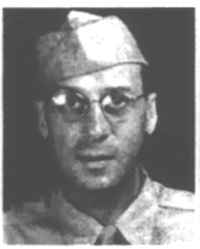
Author's great-uncle, killed in the sinking |
Sources
The Night before Christmas, Jacquin Sanders
The S.S. Leopoldville Disaster, Allan Andrade
Philadelphia Inquirer, various issues from 1945
Letter from a survivor
Photo sources:
U-486 crew photo courtesy of George Cippoletti/Vince Codianni
Photo of Leopoldville courtesy of Ray Roberts
Photo of wreck courtesy of Bertrand Sciboz
This article was published on 14 Apr 2000.
Buy this title at amazon.co.uk £ 24.95 |
Books dealing with this subject include
|
